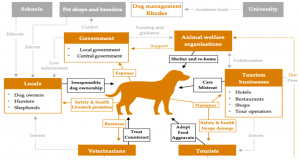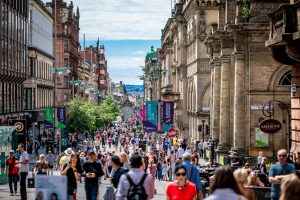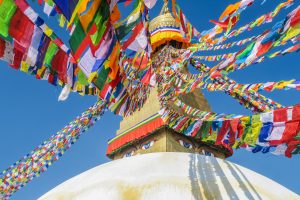Introduction
Tourism is an important asset of the Ghanaian economy, the fourth highest in foreign exchange earnings after cocoa, gold and remittances, and provides both direct and indirect employment. The total contribution of tourism to the country’s Gross Domestic Product (GDP) in 2017 was 6.2% (about $2.9 million) and tourism contributed to 5.3% (682,000) of the total employment in the country for that same year (WTTC, 2018). Moreover, international tourist arrivals to Ghana in 2014 crossed the 1 million mark (1,093,000). The Netherlands rank fifth among the tourist generating countries for Ghana (GTA, 2018).
Ghana has the natural and cultural/heritage resources plus the hospitality of Ghanaians to appeal to any tourist in the world. At the same time, the destination faces challenges that have an impact on its competitiveness. Two prominent and related challenges are the non-awareness of Ghana as a ‘must see’ destination and the limited investment by the industry in marketing Ghana to potential incoming tourists. A third challenge is that Ghana is situated within a continent described by the United Nations World Tourism Organisation (UNWTO) as having negative image. This acts as a major deterrent to international tourists and presents a challenge in creating a good image outside the continent (Awaritefe, 2005).
According to Boo and Busser (2006), images have a huge influence on the choice of a tourist to visit a destination, on the visitors’ behaviour and on their satisfaction. A destination image evolves at two levels; organic and induced (Gunn, 1988 cited in Awaritefe, 2005). An organic image of a destination, in the eyes of (potential) tourists, is formed at an early stage and is based on what is learnt about the destination through newspaper reports, magazine articles, television reports, and other non-specific information sources. An induced image is formed through promotion and other advertising media, influenced by tourism organisations’ direct information. The onus rests on the managers of Ghana’s tourism to find ways to create a good destination image, to attract more international tourists into the country and to find other sources of investment, apart from the government.
The Ghanaian culture could be used to create a destination image for Ghana. Culture is a more eloquent communicator of national image than commercial brands, even if it does work more slowly (Anholt, 2005). Anholt (2007) is of the opinion that culture plays a critical role in moving the current image of a country towards a more useful one. An entire citizenry can be fired up in becoming a mouth-piece of a country’s values and qualities to create an advertising medium which is up to the task of communicating something so complex to many (Anholt, 2007). The Ghanaian diaspora can play a special role in this respect, via the interactions they have with local communities.
This diaspora also offers potential in the sense that migrant remittances can be used to finance investments in new enterprises (e.g. tourism) either by the family and associates of migrants or by migrants themselves on their return (de Haas, 2009; UNWTO, 2009; Adepoju, 2010). Brinkerhoff, 2006, (cited in Adepoju, 2010) added that diasporas may be much more effective than foreign investors, since they have better knowledge of the local economy than investors do, and because they can combine knowledge with skills, as well as tap into networks developed abroad to yield synergistic advantages
The research underlying this article explored how an organic image of Ghana can be created using the Netherlands-based Ghanaian diaspora as a non-specific tourism information source and an avenue to provide investment for tourism development in their home country through their transnational activities. Ghanaians are part of the new diaspora that are growing in the world (Hannerz, 1992) but their exact numbers in the Netherlands are actually unknown.
The goal for the research was to evaluate and analyse how the Netherlands-based Ghanaian diaspora can be used as a non-specific information source in creating an organic image to the Dutch community and investment opportunity for Ghana’s tourism development.
Methods
The study conducted in 2010 used the mixed method approach (interviews and survey) and three perspectives were identified: Netherlands-based Ghanaian diaspora, the Dutch community and secondary data comprising government and semi-government publications, past research and reports. The goal was to collect data from respondents who occupy different social positions and/or are likely to have divergent views (Bailey, 2007). For the primary research, 150 Ghanaians and 100 Dutch residing in the Netherlands were sampled using the snowball sampling technique. The Awareness, Interest, Desire, Action theory (Law, 1991; Getz and Sailor, 1993; cited in Awaritefe, 2005) and Destination Competitiveness model (Ritchie and Crouch, 2003 cited in Hong, 2009) acted as an interpretative guide in the analysis of the data that were collected.
Findings and Discussion
Awareness
Netherlands-based Ghanaians create awareness about Ghana through the conversations they have with the Dutch and through the hosting of Ghanaian cultural events in the Netherlands. The Dutch that were sampled indicated however there was little interaction between them and Ghanaians in their social circle.
The words ‘African’, ‘poor’ and ‘warm’ were used by the Dutch to describe Ghana. This gives an indication of the image they have about the country. Some of them are even unaware that Africa is a continent with 54 separate countries, including Ghana, and see all Africans as citizens of one country. The description of the country as poor holds true in comparison to the Netherlands, since Ghana is a developing country. Ghanaians, however, want their country to be described as having beautiful culture and has having friendly and hospitable citizenry and not by the attribute of being poor. The description of the country as warm is apt because it is situated in the tropics, just above the equator. There are moderate temperatures, constant breeze and lots of sunshine.
Both the Dutch and Ghanaians agreed on the use of Ghanaian cultural events in creating awareness. The two cultural events that were chosen by both Ghanaians and the Dutch to create awareness were musical concerts performed by Ghanaian artists and football matches between the two countries. The choice of football matches was not a surprise since it is a national passion and favourite past time in both countries.
Interest and desire
Interest in Ghana and a desire to travel to Ghana can be created among the Dutch community through the hosting of Ghanaian cultural events. Good impressions are also made when Ghanaians talk about their country. According to the Dutch, this can create an image that it is quite different than the one derived from the other information sources (e.g. newspaper, television, internet etc.) that they use to obtain information about Ghana.
Action
The last element on the AIDA theory is for the Dutch to actually make the trip to Ghana. This study found that, for the large majority of Dutch tourists, this was yet to happen. Four things that the Dutch look out for when selecting a tourist destination to visit are nice weather, acceptable
Tourism Destination Management Insights | Issue III
prices, beautiful beaches and accessibility. Price especially is a challenge because Ghana is seen as a high cost tourist destination, in respect of air fares, visa, and hotel accommodation, compared to similar tourist destinations in Africa and Europe. Managers of Ghanaian tourism therefore need to address this challenge if the country wants to attract more Dutch to experience the country’s tourism.
Investment
Netherlands-based Ghanaian diaspora indicated their willingness to invest in tourism development in Ghana. They see the potential of the industry. The areas of the industry in which they wanted to invest their remittances were accommodation, human resources and the provision of tourism services. These were the areas that managers of the industry identified as needing more investment to develop. Most Ghanaians that had expertise in the Netherlands hospitality industry expressed their willingness to offer their expertise to improve the same industry back home. Only a few of them stated that they needed government support before committing their remittances to tourism development.
Conclusion
This study established that Ghanaians in the diaspora can definitely be used as a non-specific tourism information source in creating an organic image about their homeland as a destination worth visiting. The socio-cultural activities that Netherlands-based Ghanaians use in exhibiting their ties to Ghana can improve the destination image. However, more interactions between the Dutch and Ghanaian communities are needed to create the desired awareness. Sustaining interest and desire should be a priority and extra efforts are needed to encourage the Dutch to take the action of travelling to Ghana. The Netherlands-based Ghanaian diaspora ties to Ghana, which they continue to maintain, are a resource the managers of the Ghana’s tourism industry can tap into for tourism development.





